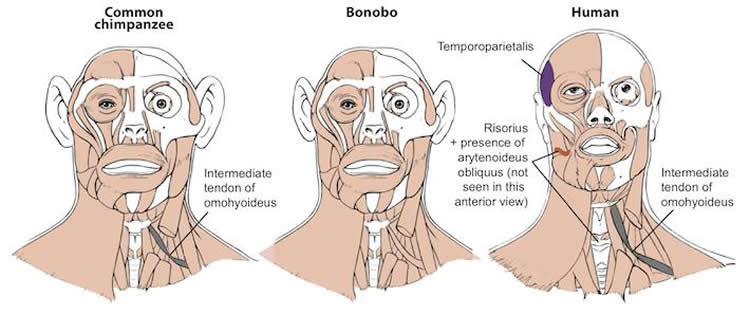Summary: A new study reveals bonobos may be more closely linked anatomically to humans than common chimpanzees are.
Source: George Washington University.
Study examined muscles of bonobos and found they are more closely related to humans than common chimpanzees.
A new study examining the muscular system of bonobos provides firsthand evidence that the rare great ape species may be more closely linked, anatomically, to human ancestors than common chimpanzees. Previous research suggested this theory at the molecular level, but this is the first study to compare in detail the anatomy of the three species.
“Bonobo muscles have changed least, which means they are the closest we can get to having a ‘living’ ancestor,” said Bernard Wood, professor of human origins at the GW Center for the Advanced Study of Human Paleobiology.
Scientists believe that modern human and common chimpanzee/bonobo lineages split about 8 million years ago with the two great ape species splitting about 2 million years ago. As common chimpanzees and bonobos evolved after their split, they developed different traits and physical characteristics, even though they remained geographically relatively close, with their main division being the Congo River. Because of this, researchers have been curious as to what those differences are and how they compare to humans. By studying the muscles of bonobos (which indicates how they physically function), the team was able to discover that they are more closely related to human anatomy than common chimpanzees, in the sense that their muscles have changed less than they have in common chimpanzees.
Earlier studies examined the DNA similarities and differences between bonobos and common chimpanzees, but this was the first study to compare the muscles of the three species.

“In addition, our study has shown that there is a mosaic evolution of the three species, in the sense that some features are shared by humans and bonobos, others by humans and common chimpanzees, and still others by the two ape species,” said Rui Diogo, lead author of the paper and associate professor of anatomy at Howard University. “Such a mosaic anatomical evolution may well be related to the somewhat similar molecular mosaic evolution between the three species revealed by previous genetic studies: each of the chimpanzees species share about 3 percent of genetic traits with humans that are not present in the other chimpanzee species.”
The researchers led a team that examined seven bonobos from the Antwerp Zoo that had died and were being preserved. Researchers said this was an extremely rare opportunity given bonobos’ status as an endangered species.
The scientists note that having a clear understanding of what makes humans different from our closest living relatives might lead to new breakthroughs or understandings of human health.
Source: Emily Grebenstein – George Washington University
Image Source: NeuroscienceNews.com image is credited to Julia Molnar.
Original Research: Full open access research for “Bonobo anatomy reveals stasis and mosaicism in chimpanzee evolution, and supports bonobos as the most appropriate extant model for the common ancestor of chimpanzees and humans” by Rui Diogo, Julia L. Molnar & Bernard Wood in Scientific Reports. Published online April 4 2017 doi:10.1038/s41598-017-00548-3
[cbtabs][cbtab title=”MLA”]George Washington University “Bonobos May Be Better Representation of Last Common Ancestor With Humans: Brain Views Immoral Acts As If They Are Impossible.” NeuroscienceNews. NeuroscienceNews, 29 April 2017.
<https://neurosciencenews.com/bonobos-evolution-6542/>.[/cbtab][cbtab title=”APA”]George Washington University (2017, April 29). Bonobos May Be Better Representation of Last Common Ancestor With Humans: Brain Views Immoral Acts As If They Are Impossible. NeuroscienceNew. Retrieved April 29, 2017 from https://neurosciencenews.com/bonobos-evolution-6542/[/cbtab][cbtab title=”Chicago”]George Washington University “Bonobos May Be Better Representation of Last Common Ancestor With Humans: Brain Views Immoral Acts As If They Are Impossible.” https://neurosciencenews.com/bonobos-evolution-6542/ (accessed April 29, 2017).[/cbtab][/cbtabs]
Abstract
Bonobo anatomy reveals stasis and mosaicism in chimpanzee evolution, and supports bonobos as the most appropriate extant model for the common ancestor of chimpanzees and humans
Common chimps and bonobos are our closest living relatives but almost nothing is known about bonobo internal anatomy. We present the first phylogenetic analysis to include musculoskeletal data obtained from a recent dissection of bonobos. Notably, chimpanzees, and in particular bonobos, provide a remarkable case of evolutionary stasis for since the chimpanzee-human split c.8 Ma among >120 head-neck (HN) and forelimb (FL) muscles there were only four minor changes in the chimpanzee clade, and all were reversions to the ancestral condition. Moreover, since the common chimpanzee-bonobo split c.2 Ma there have been no changes in bonobos, so with respect to HN-FL musculature bonobos are the better model for the last common ancestor (LCA) of chimpanzees/bonobos and humans. Moreover, in the hindlimb there are only two muscle absence/presence differences between common chimpanzees and bonobos. Puzzlingly, there is an evolutionary mosaicism between each of these species and humans. We discuss these data in the context of available genomic information and debates on whether the common chimpanzee-bonobo divergence is linked to heterochrony.
“Bonobo anatomy reveals stasis and mosaicism in chimpanzee evolution, and supports bonobos as the most appropriate extant model for the common ancestor of chimpanzees and humans” by Rui Diogo, Julia L. Molnar & Bernard Wood in Scientific Reports. Published online April 4 2017 doi:10.1038/s41598-017-00548-3






